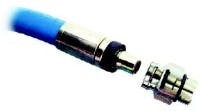No threads? No problem.
In January 2001, Rian Meyeres, engineering supervisor for John Deere, Moline, Ill., was the leader of a design team that decided to switch the end fittings on the hydraulic brake and power steering lines of their G-Series backhoe loaders over to a different technology. "We were pleased with the O-ring face seal fittings — the incumbent industry standard for construction equipment. But using Eaton Aeroquip's STC (Snap To Connect) threadless connectors on the steering valve and brake lines allow connections to pivot when they were not pressurized. This occurs, for example, when the cab of the backhoe is opened or closed. In the same application, threaded connections can back-out and leak."
Meyeres continued, "That's what initially drove us to STC technology. But since we introduced it, another big plus has been its impact on production. STC connectors provide better access in cramped areas, allowing us to better and more quickly service hoses. As a result, we're seeing significant improvements in time, labor, and productivity. It's hard to argue against something that provides better, faster, and more accurate assembly while saving money all around.
"Before we made any decisions, we put together a team to really investigate STC, and we made sure that assemblers were involved in the decisionmaking process. Everyone agreed that it was a more robust design. After beta testing and training seminars, we rolled out the STC system. Not only have there been no complaints from the plant floor, but we've realized a 50% reduction is assembly time and enhanced production robustness."
The technology behind STC
According to Scott Campbell, product manager, "STC technology was patented as a threadless connector in 1993. The original system was designed to operate as a simple, leak-free connection method for use in hydraulic systems working at pressures to 6000 psi. It is a system of threadless connectors that incorporates a latch ring to positively engage the mating connectors and an elastomeric seal to prevent leakage. Since its initial development, over 13 million STC threadless connectors have been put into use over a range of equipment applications. And there hasn't been a single field failure or warranty claim."
But STC technology has gone beyond its initial potential for simply providing leak-free connections only. Raja Rajagopalan, group product manager for Eaton, offered, "Reliability is the key to acceptance of new technology in the hydraulics-marketplace. Years of testingin the lab and in the field have focused on providing a leak-free system that is absolutely reliable. Connectors have been there since the dawn of hydraulics. The value we add to the mix is peace of mind. A high priority for engineers is making sure that what's in place is robust and reliable."
Faster assembly
One of the ways STC technology has proven itself as a significant cost-saver is on the assembly side. "On average," explained Rajagopalan, "it takes 60 to 75 sec for an assembler to hand-tighten and then torque down a standard hydraulic connection — and there's always the chance for that connection to be over- or under-torqued. With the female STC port machined in, that same connection can take only two to three sec — with no opportunity for an incorrect torque. Each second saved has a dollar value on that machine. And that's multiplied by hundreds of connections per machine."
Eaton has also tested the reusability of the STC connection by connecting and disconnecting each size 250 times in their research laboratory. And even after the 250th connection, no adverseimpact on performance was observed — an important aspect to both manufacturers as well as end-users.
Testing and verification
"Deere's own verification testing shows the STC system to be as good, or better, than the current SAE standard for the O-ring face seal fittings," said Meyeres. "We're very pleased with STC and are looking to use this technology in other lines. It's a real benefit to our assemblers, to our customers, and to our bottom line."
John Deere, long recognized as a leader in the production of mobile hydraulic equipment, is one of the first manufacturers to capitalize on the advantages of STC technology. According to Meyers, " It would be wonderful to have an industry standard on STC, because every company all over the globe can reap the same benefits that Deere is enjoying. It will drive the total industry cost down and help the machines be more cost competitive."
Campbell responded, "We're working with the hydraulic industry, and we hope to have an adopted standard shortly."
Qualification testingThe standard STC configuration incorporates a female STC adapter threaded onto the body of a pump or valve, with the male part fitted to the hose end. Manufacturers can also specify a machined-in female port, allowing more rapid assembly. "It is our intention to do away with the adapter," says Scott Campbell. To the OEM, having a machined female port translates into even greater cost savings. With a female direct port, the operating pressures can go even higher than with the female direct port in an adapter format. Eliminating the threaded female STC adapter, another possible leak path is removed." Test results published by Eaton Aeroquip reveal the following: |
Click here to go to Eaton's Snap-to-Connect web page.


